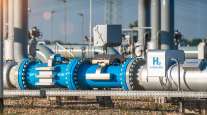Kansas Raises Highway Overpasses to Give Trucks Clearance

Inch by inch, over about eight hours, some Kansas Turnpike overpasses are being elevated by at least a foot to make sure big freight trucks can pass underneath.
“We’ve had a few bridges hit,” said Rachel Bell, communication director for the Kansas Turnpike Authority.
Furthermore, some trucking companies have told the authority they’d use the toll road more if the bridges had higher clearances, Bell said.
The Kansas City-based engineering firm of Burns & McDonnell began this fall to work on a $3.7 million contract to raise 10 bridges over Interstate 35. The work began near Wellington and South Haven in southern Kansas.
The bridges, dating to turnpike’s opening in 1956, have clearances as low as 14 feet, 6 inches — sometimes not enough for today’s tall trucks. All 10 spans are being elevated to at least 15 feet, 9 inches.
“Any time you can have a route that minimizes vertical clearance problems, it opens things up for more efficient routes,” said John Maddox, program manager for the freight and rail unit within the Kansas Department of Transportation. “Tall, wide and long loads continue to increase in size and numbers, so any time we can modify bridges, it opens us up to more traffic.”
Three of the turnpike lifts have been done this year. The remaining seven under the current contract are to be worked on beginning in mid-March, said Rod Lacy, manager of Burns & McDonnell’s highway department.
Beyond the first 10 bridge elevations, there isn’t a timetable yet for raising the turnpike’s other bridges.
“We looked at the easiest bridges first,” Bell said. “On the north end between Kansas City and Topeka, we’ll be implementing open-road tolling over the next few years, and we’ll incorporate the bridge lifts with that.”
Open-road tolling will move the toll plazas that extend across the turnpike to the sides of the roadway and install electronic readers to capture tolls from trucks and cars that are equipped with transponders, the stickers placed on windshields that are read when vehicles pass. Drivers using cash or credit cards will pull to the sides of the turnpike to pay.
Bell said turnpike bridge and road work will begin in the Kansas City area in 2018. Contracts for that part have yet to be awarded. Lacy said Burns & McDonnell will pursue that work, too.
“We’re interested in any bridge lift,” Lacy said. “You can easily spend $2 million to $3 million each to build the kinds of bridges we’re talking about. These lifts can be done at a fraction of the cost.”
The turnpike authority has a long-term plan to spend $1.2 billion on turnpike improvements, including elevating more bridges over the 236-mile turnpike route over the next 10 years. Tolls from turnpike users support the work.
The span-lifting process uses hydraulic lifts positioned at the ends and the center of the bridges. While the work to raise up to 578,000 pounds of steel and concrete is under way, traffic continues to flow on the highway beneath the bridges as they’re ratcheted higher.
All 10 of the bridges were studied and deemed to be in good enough condition to be raised rather than demolished and replaced. Most of them serve county roads.
Lacy said that meant the affected bridges have been in very good shape despite their age, thanks to limited traffic over them and because they haven’t suffered the effects of snow and ice treatment.
Each bridge project takes 30 to 40 days to do the site preparation and follow-up work, and the county roads that go over the bridge are closed for that period.
Once the actual lifting begins, it takes only one day to pump, shimmy, inspect and repeat the 1-inch steps. Turnpike traffic sees the hydraulic lifts in place and concrete safety barriers to protect the work zone, but there’s no turnpike stoppage.
After the desired height is reached, the new bridge bearings are secured on concrete piers, Lacy said. The bridge approaches then are regraded and new guardrails are installed.
Burns & McDonnell won the contract using a process known as EPC, which stands for engineering, procurement and construction. The company says the process allowed for a lower-cost bid and savings to the authority.




